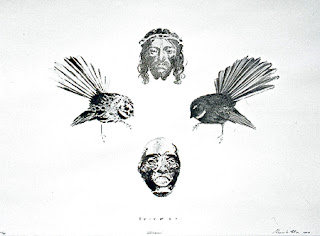'Pluralism in art refers to the nature of artforms ad the artists as diverse. The cultural context of individuals of differing ethnicities, genders, ideologies, abilities, ages, religions, economic status and educational levels in valued. Pluralism honours differences within and between equitable groups while seeing their commonalities' (Caldwell, 1990)
2. How would you describe New Zealand's current dominant culture?
New Zealand's dominant culture is a mixture of the british and maori influence.
3. Before 1840, what was New Zealand's dominant culture?
Maori were still the dominant culture but the british population were progressively growing because of the whalers and sealers, missionaries, and traders.
4. How does the Treaty of Waitangi relate to us all as artists and designers working
in New Zealand?
There is a lot of cultural diversity in New Zealand and that effects post modern art because of pluralism. Without the Treaty of Waitangi there might have been a different culture in NZ. Maori could be the dominant culture.
5. How can globalization be seen as having a negative effect on 'regional diversity' that leads to a 'homogenized world culture' in New Zealand in particular? (ALVC2 handbook page 52, http://searchcio.techtarget.com/definition/globalization)
Countries that are wealthier could take advantage of poorer countries and this means they become the dominant culture in that country. In New Zealand this happened with the British taking advantage of the Maori by both of them signing the Treaty of Waitangi. This meant the British were very well done by this deal and it left the Maori out of land and their population didn't grow as fast as the British.
6. Shane Cotton's paintings are said to examine the cultural landscape. Research Cotton's work 'Welcome'(2004) and 'Three quarter view ' (2005) to analyze what he is saying about colonialization and the Treaty of Waitangi.
Cotton's Three Quarter View is a mixture of Maori and british aspects. The main image is of Barnet Burns, a british flax trader that decided to get a full face tattoo and live with Maori. 'The combination alludes to the complex relationship between Christianity, colonialism and contemporary culture. Cotton’s art questions the notion of cultural identity, looking instead to the space between Maori and Pakeha perspectives.'
Shane Cotton Welcome (2004)
Shane Cotton Three Quarter View (2005)
7. Tony Albert's installation 'Sorry' (2008) reflect the effects of colonization on the aboriginal people of Australia. Research the work and comment on what Albert is communicating through his work, and what he is referring to. Describe the materials that Albert uses on this installation and say what he hopes his work can achieve.
Albert uses kitsch ans stereotypical items placed on the word 'SORRY' to reflect on the pain Aborigines have suffered over the years by the British. "My work is always about appropriation, that's why it exists," Albert says. "The Sorry work is about my personal collection which, in a way, was always a comfort to me. There were images of Aboriginal people around me and my collecting these objects was my way of marking my respect."
Tony Albert Sorry (2008)
8. Define the term 'kitsch'.
'something of tawdry design, appearance, or content created to appeal to popular or undiscriminating taste.'
9. Explain how the work of both artists relates to pluralism.
They take from different cultures and and their difficulties and create something that is both a celebration of the culture as much as it is bringing attention to all the problems and hardships they have suffered in the hands of the British.
http://cs.nga.gov.au/Detail.cfm?IRN=149998
http://dictionary.reference.com/browse/kitsch
http://www.theaustralian.com.au/arts/curios-of-the-contemporary/story-e6frg8n6-1111119151528



No comments:
Post a Comment